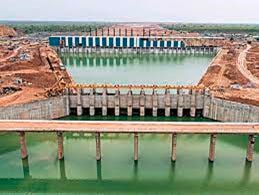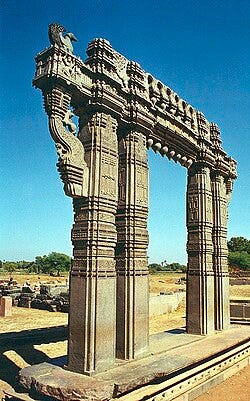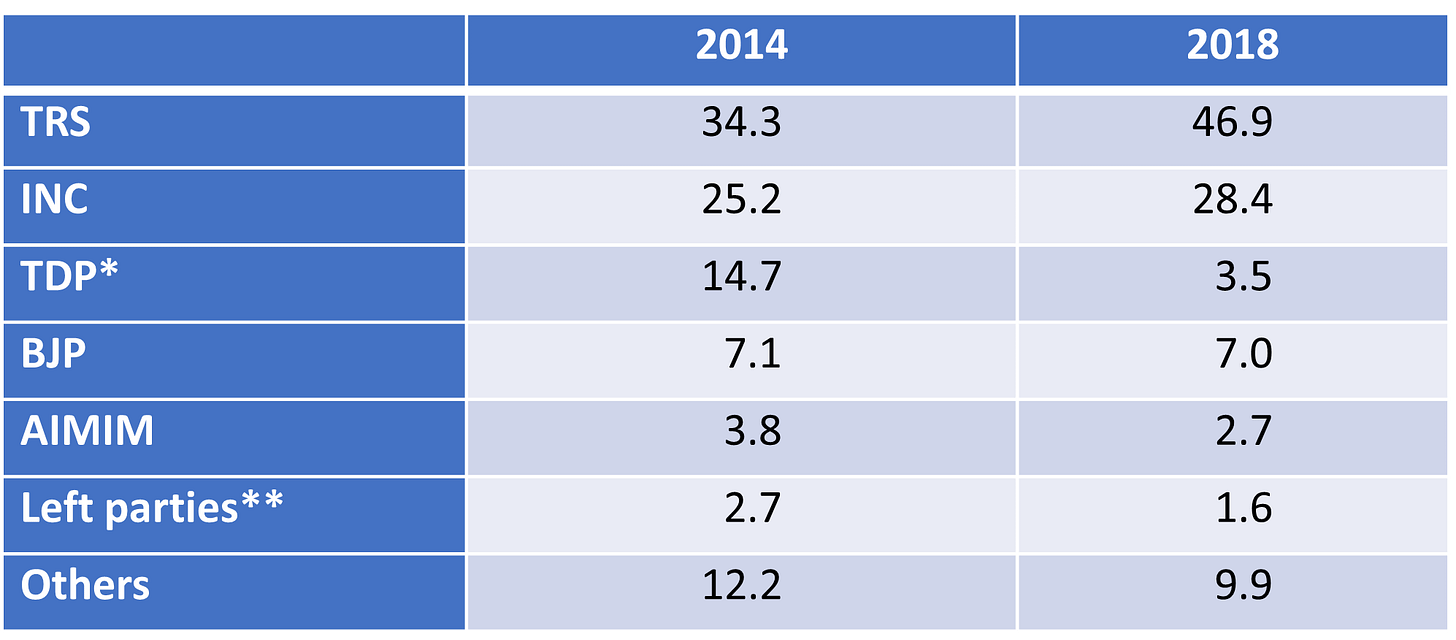The title is inspired by K. Chandrashekar Rao (KCR) who remains the contemporary brand ambassador of Telangana, and the election symbol of his party, the Bharat Rashtra Samithi BRS - the Ambassador car.
Introduction:
Telangana is the newest state of India and acquired full statehood on 2 June, 2014. The state is India’s 11th largest and represents a fusion of religions and cultures. Hyderabad, famous for its cuisine, architecture and culture exemplifies this melting point of diversity. In the first part of this series, we will explore the geography and history of Telangana to understand the reasons for its unique identity and demand for separate statehood. We will analyse the Telangana separation movement and see its implications on the state’s politics. Finally, I will present an overview of the state’s politics and its various players.
Geography:
Plateaus and the presence of the rivers Godavari (in the North and East), Krishna in the South define Telangana’s topography. Telangana is strategically important for downstream agricultural regions since most of the catchment area of the Godavari and the Krishna lies within the state.
The region is quite arid (average rainfall excluding the Godavari region is around 700-900 mm per annum. Historically, the region has depended rain-fed agriculture and on man-made tanks/lakes to even out water fluctuations, since most of the land lies at a higher elevation than the rivers. The host of lift irrigation projects undertaken in the last decade or so has transformed agriculture in this region and has therefore had important political ramifications. History too has shaped this region and that is what we will turn to next.
The Nagarjuna Sagar built on the Krishna River on the Andhra Pradesh Telangana border in 1967, is the largest masonry dam in the world.
The Kaleshwaram Lift Irrigation Project on the Godavari is the world’s largest multi-stage project, and was inaugurated in 2019. It involved an initial outlay of Rs. 80,000 crores
The Hussain Sagar is a heart shaped lake in Hyderabad built by Ibrahim Quli Qutb Shah in 1563 on the Musi river. This combined with the Osman Sagar and the Himayat Sagar (both built in the early 20th century) is the source of Hyderabad’s water supply.
History:
Pre-Indian Independence History
From the Mauryas to the Deccan Sultanate, several dynasties have ruled Telangana. However, only the Kakatiya dynasty (12th-14th century CE) and the Asaf Jahi dynasty (1671-1948) had roots in this region. The Kakatiyas ruled over a region that covered present-day Telangana and Andhra Pradesh and the legacy of their court language, Telugu, persists today. The Asaf Jahi dynasty moved their capital to Hyderabad in the late eighteen century and ruled for 250 years. These two phases of history have therefore been most impactful.
After the Kakatiya period, Andhra Pradesh and Telangana were ruled separately. Andhra Pradesh came under the Vijayanagar Kingdom, the Mysore Kingdom and then the British, while Telangana was ruled by the Khiljis, Mughals and the Asaf Jah dynasty. The Nizams ruled Hyderabad as a princely state during the British occupation of India, and Operation Polo in 1948 brought it into the Indian Union.
Apart from rulers, Andhra Pradesh and Telangana developed different political and economic frameworks. Syncretic Urdu-Telugu culture, feudal revenue collection systems (the durra system) and monarchic traditions (Patel Patwari system) defined the Nizam’s domains. Resentment against oppressive exploitation led to the communist-inspired farmer rebellion (1946-51) against durras (landlords) and sahukars (moneylenders) that resulted in the loss of the Nizam’s control over Eastern Telangana. An enduring consequence of the revenue collection system is the absence of clear land records in the region.
Andhra Pradesh- was under British administration as part of the Madras Presidency. The disparity in economic, educational and social advancement between the two areas in this period created apprehensions in Telangana that it would be dominated by Andhra Pradesh in a unified scenario, and this is exactly what transpired next.
Post-Indian Independence History
1948-56
After Operation Polo, the Central Government deputed a civil servant – M.K. Vellodi to take over as the first CM of the state. Bureaucrats were also deputed from the erstwhile Bombay and Madras Presidencies to assist him in administration (since most of the existing bureaucracy had been purged after Operation Polo). Four separate political movements – 2 each originating from Andhra Pradesh and Telangana, shaped politics in the next decade. The demand for separate statehood for all Telugu speaking areas in the Madras Presidency and Vishalandhra (integration of all Telugu speaking areas, including Telangana) became popular in Andhra Pradesh. In Telangana, an agitation to remove ‘imported’ bureaucrats out from Hyderabad began and the farmer rebellion continued. The farmer rebellion was quelled using a combination of military and political means and consequently, the Communist Party of India (CPI) agreed to join the political mainstream in 1951. The enduring relevance of communist parties in Eastern Telangana has roots in this agitation. The Indian National Congress (INC) came to power in the first elections held in Hyderabad state in 1952 and remained in power till 1956. The INC also came to power in the newly created Andhra State in 1952. As part of a grand political bargain, politicians of both regions agreed to a Unified Andhra Pradesh, that then came into existence in 1956.
1956-2009
Three efforts to create a Telangana state occurred in 1969, 1972, and 2009. These 3 trends directly affect state politics, so we'll explore them next. The Jai Telangana movement of 1969 sought partly to implement ‘safeguards’ against Andhra settlers in Telangana, or otherwise provide separate statehood. A new party called Telangana Praja Samithi (dominated by INC dissidents) won 10 out of 14 parliamentary seats in the 1971 elections and became a potent political force for separate statehood. This agitation was quelled by the deployment of the army to maintain law and order and a political settlement that involved rehabilitation of TPS leaders into the INC, and the appointment of P.V. Narasimha Rao (a Telangana Congress leader and later PM of India) as the CM of Unified Andhra Pradesh in 1971.
The next stage of political upheaval started in 1971 with the Supreme Court upholding the Mulki Rules in Hyderabad1. Consequently, the Jai Andhra movement started in Andhra Pradesh against what was perceived to be discrimination against them in their own state. Once again, the army had to be called in and the agitation was resolved with all sides agreeing to implement a six-point plan with the Central Government in 1973.
Mulki (sons of the soil) rules were in force in Hyderabad state during the Nizam’s rule. According to these, residing within the dominion for 15 years and working for the government for 12 years entitled a person and his family to be considered the dominion’s residents. Residents had preferential access to education and employment in Hyderabad.
From 1973 until 1997, demand for statehood waned for two reasons. From 1971 to 1980, the INC put three Telangana politicians as CMs across the state, calming separatist tension. Second, the charismatic NT Rama Rao dominated Unified Andhra Pradesh politics for two decades starting in 1980, appealing to Telugu pride and unity. As a result, the demand for Telangana may have remained quiet until his 1996 death. In 1997 and 2000, the BJP and INC state units demanded statehood after his death. The 2002 NDA administration of Atal Bihari Vajpayee rejected these demands, probably because NTR's Telugu Desam Party, a constituent of the NDA, opposed them. K. Chandrashekar Rao (KCR) founded the Telangana Rashtra Samithi in 2001 with the single point agenda of creating a separate state. The TRS and INC won a huge victory in the Lok Sabha election in 2004 as part of the United Progressive Alliance in Unified Andhra Pradesh.
2009-14
By 2009, most national parties came around to supporting a separate Telangana. The TRS suffered severe electoral setbacks in both Vidhan Sabha and Lok Sabha elections of 2009- it won 10/119 seats in the Vidhan Sabha and 2/17 seats in the Lok Sabha, primarily because it was no longer the only party pressing for separate statehood. The demise of the CM of Unified Andhra Pradesh- Y.S. Rajasekhara Reddy in 2009 created a power vacuum. KCR then successfully wrested the political initiative with his fast unto death in late 2009, that resulted in the announcement of the process of bifurcation by the Union Government in 2010 and its subsequent roll back in the wake of protests on both sides. In its search for a political consensus, the Justice Srikrishna Committee was constituted which in its 2011 report , noted that ‘separation is recommended only in case it is unavoidable and if the decision could be reached amicably’. The Commission notes in its papers that there were serious disparities in water sharing, education infrastructure and public employment between the two regions. By then, the TRS had made this an emotive and popular subject in Telangana and garnered popular support. The 2009 Telangana Joint Action Committee, chaired by Prof. M. Kothandaraman, sought consensus among all organisations for a separate Telangana. In 2018, he founded the Telangana Jana Samithi, which did poorly in the polls. After public protests, blockades, non-cooperation, and mass political resignations, the Union cabinet approved the Andhra Pradesh reorganisation bill in 2013 and Parliament ratified it in early 2014. Telangana came into existence on 2 June 2014 which is hence called Telangana Formation Day. The establishment of Telangana showed that no major party, except the TRS, adopted a consistent position on the matter. Therefore only the TRS benefited from its electoral dividend. The national parties (INC, BJP) were marginalised in Andhra Pradesh and Telangana due to their perceived flip-flops, and even 10 years later, they have not regained influence over the political narrative in both states.
Politics of Telangana
As mentioned before, Unified Andhra Pradesh had only 3 CMs from the Telangana region, with a combined tenure of around 9 years in its 58 year existence2. These 3 CMs were P.V. Narasimha Rao, Jalagam Vengala Rao and Marri Chennai Reddy. Since the formation of the state in 2014, there have been 2 elections held in 2014 and 2018 respectively, that were both won by the TRS. The politics of the state have been largely dominated by the INC and TRS and as table below shows, the state become more bi-polar in 2018. (the combine got 75.3% of the vote in 2018 compared to 59.5% in 2014).
*- TDP allied with BJP in 2014 and with INC in 2018.
**- Includes CPI, CPIM and AIFB (All India Forward Bloc)
The All India Majlis E-Ittahadul-Muslimoon (AIMIM) is a party headed by Asaduddin Owaisi that dominates the politics of 7 constituencies in the Old Hyderabad City. The left parties continue to have pockets of support in the areas bordering Andhra Pradesh, though this support seems to be declining.
This bi-polar political situation changed with the emergence of the BJP as a strong player in the 2019 Lok Sabha elections (it won 4 seats out of 17 with 19.65% vote share). Its subsequent strong performance in Hyderabad municipal polls (it came second), wins in some bye-elections and defections of key leaders (like Eatala Rajender, who is profiled below) has led many to speculate that Telangana will see a tri-cornered contest in 2024. The TRS on the other hand, revealed its national political ambitions by rechristened itself as Bharat Rashtriya Samithi (BRS) in 2022.
No analysis of politics is complete without looking at the key players involved, and this is where we will focus next.
The linked paper provides a wonderful overview of the Mulki rules and the political, economic and social context prevalent in Andhra Pradesh and Telangana.
Unified Andhra Pradesh had 3 regions- Rayalseema, Coastal Andhra and Telangana.









